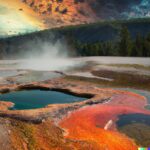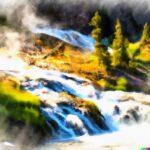Welcome to the fascinating world of geysers, natural wonders that never fail to captivate and amaze us with their explosive beauty. In this article, we will explore the definition of geysers, where you can find them around the world, and delve into the unique geology of Yellowstone National Park – home to some of the most famous geysers on Earth.
From the iconic Old Faithful to the mysterious Steamboat Geyser, we will uncover the secrets behind what causes these incredible eruptions and the different eruption patterns that make each geyser in Yellowstone truly unique. Get ready to be awed by the power of nature as we take a closer look at these incredible geothermal features.
What Are Geysers?
Geysers are natural geological phenomena characterized by periodic hot water eruptions, often associated with geothermal features, thermal springs, hydrothermal activity, and volcanic processes.
These unique features are a result of underground water being heated by magma chambers, creating pressure that builds up until the water forcefully ejects, creating the impressive eruptions that geysers are known for.
The connection to geothermal activity is crucial as it highlights the role of heat transfer from the Earth’s interior in generating these fascinating hydrothermal displays.
The presence of minerals dissolved in the hot water contributes to the vivid colors often seen in the surroundings of geysers, adding to their allure and visual appeal.
What Is The Definition Of A Geyser?
A geyser is a geothermal feature that erupts periodically with hot water and steam, driven by underground hydrothermal activity and volcanic processes.
These natural wonders are typically found in regions with high volcanic activity, such as Iceland and Yellowstone National Park.
The eruption of a geyser is triggered when water seeps deep into the Earth’s crust, where it is heated by the magma below. As the water heats up, pressure builds up until it eventually erupts in a powerful jet of steam and hot water. The periodicity of geyser eruptions is influenced by the amount of water available, the underground water pathways, and the heat source from the Earth’s core.
Where Can You Find Geysers?
Geysers can be found in various locations worldwide, with Yellowstone National Park in Wyoming standing out as a prominent destination known for its geothermal wonders and captivating geyser displays.
The park is home to the famous Old Faithful geyser, which shoots water high into the air at regular intervals, mesmerizing visitors with its natural spectacle. Yellowstone’s diverse landscape, dotted with colorful hot springs, bubbling mud pots, and steaming fumaroles, offers a unique opportunity to witness the raw power of the Earth’s geothermal activity up close. The park’s geysers not only provide a visually stunning experience but also serve as important natural features that play a crucial role in the ecosystem, supporting a variety of unique flora and fauna.
What Are The Most Famous Geysers In The World?
Some of the most famous geysers in the world are renowned for their spectacular geothermal features, stunning thermal springs, and allure as top tourist attractions.
These natural wonders hold significant appeal not only for their unique geological formations but also for the mystique and power they exhibit. Visitors flock from far and wide to witness the mesmerizing eruptions of boiling water shooting skyward and the mesmerizing steam rising from the vibrant pools. Known for their unpredictability and natural beauty, these geysers are not only breathtaking to behold but also serve as a reminder of the Earth’s impressive and volatile natural forces at work.
What Makes Yellowstone National Park Unique?
Yellowstone National Park is a geologic marvel renowned for its unique landscapes, captivating geysers, and abundant geothermal energy resources, making it a distinctive national park with global recognition.
The park’s distinctiveness lies in its extraordinary geological features, such as the Grand Canyon of the Yellowstone and the colorful hot springs like the Grand Prismatic Spring. These geothermal wonders showcase the Earth’s inner workings, attracting visitors worldwide to witness the power and beauty of nature’s geological forces.
The iconic Old Faithful geyser, erupting at regular intervals, epitomizes the park’s dynamic geothermal activity, while also serving as a reminder of the importance of sustainable energy sources, like geothermal energy, in modern conservation efforts.
What Is The Geology Of Yellowstone National Park?
The geology of Yellowstone National Park is characterized by its volcanic landscapes, intricate hydrothermal processes, and iconic geysers that reflect the park’s dynamic geological history.
Formed over thousands of years, Yellowstone’s geological composition showcases a diverse range of volcanic features like calderas, lava flows, and volcanic craters. The park sits atop a hotspot, causing continuous volcanic activity that has shaped its unique terrain.
Throughout the park, visitors can witness colorful hot springs, mud pots, and fumaroles, all products of the park’s underlying volcanic origins. The hydrothermal processes at work within Yellowstone create a dynamic ecosystem, sustaining unique microbial life that thrives in extreme conditions, contributing to the park’s remarkable natural beauty.
What Are The Main Geysers In Yellowstone National Park?
Yellowstone National Park boasts numerous geysers, with iconic ones like Old Faithful captivating visitors with their spectacular hot water eruptions and mesmerizing thermal pools.
Visitors flock to witness the rhythmic eruptions of Old Faithful, which spouts scalding water up to 184 feet into the air in impressive displays that occur at intervals ranging from 45 to 125 minutes. The park’s thermal pools, such as the vividly-hued Grand Prismatic Spring and the steamy Excelsior Geyser, offer a glimpse into the park’s geothermal wonders. Exploring the geyser basins provides an awe-inspiring experience, where the earth’s raw power is on full display, creating a surreal and otherworldly atmosphere for all who venture into this unique natural wonderland.
Old Faithful
Old Faithful is one of the most iconic geysers in Yellowstone National Park, known for its regular and impressive eruptions that showcase the park’s rich geothermal activity, providing visitors with a memorable experience.
Its eruptive patterns follow a predictable schedule, shooting boiling water and steam up to 184 feet into the air. This reliable display occurs approximately every 90 minutes, allowing eager onlookers to witness nature’s spectacle.
The geyser’s thermal features create a mesmerizing ambiance, surrounded by colorful mineral deposits and bubbling hot springs. Visitors can also explore nearby boardwalks and observation points for a closer look at the geothermal wonders that make Yellowstone a unique destination for nature enthusiasts.
Grand Geyser
Grand Geyser is a mesmerizing geyser in Yellowstone National Park, renowned for its grandeur and captivating display of geothermal wonders, featuring unique geothermal vents that add to its allure.
It is a true spectacle to witness the grand eruptions of Grand Geyser, as it shoots hot water and steam high into the air with incredible force, creating a dramatic and unforgettable sight for visitors. The geothermal vents surrounding the geyser contribute to the overall mystique of the area, showcasing the raw power and beauty of Yellowstone’s geothermal features. The combination of bubbling pools, colorful mineral deposits, and the rhythmic rumblings of the earth below make this geyser a must-see attraction for anyone exploring the wonders of the park.
Castle Geyser
Castle Geyser stands out among Yellowstone’s geysers with its unique castle-like structure and captivating geothermal features that intrigue geologists and visitors alike, offering insights into geothermal exploration.
The iconic castle-shaped silhouette of Castle Geyser adds a touch of mystique to the dramatic landscape of Yellowstone National Park. Its eruptions, reaching heights of up to 90 feet, are a mesmerizing display of nature’s raw power. The surrounding mineral deposits create a surreal and colorful backdrop, enhancing the overall appeal of this geological wonder.
Geothermal activity in the area has long fascinated scientists and researchers, as Castle Geyser’s behavior provides valuable data for understanding the underground processes at work in this volcanic region.
Beehive Geyser
Beehive Geyser earns its name with towering eruptions resembling a beehive, showcasing the dynamic nature of erupting geysers and the intricate geothermal systems that power these natural phenomena.
The mesmerizing eruptions of Beehive Geyser captivate onlookers as they marvel at the natural spectacle unfolding before them. The rhythmic bursts of steaming water shooting high into the sky evoke the buzzing activity of a beehive, earning the geyser its fitting name.
These eruptions, fueled by the underlying geothermal energy beneath the Earth’s surface, exemplify the intricate balance of pressure, temperature, and water supply necessary for such geothermal features to thrive. Understanding the dynamics of these eruptions provides valuable insight into the wondrous processes at work within our planet’s geothermal systems.
Steamboat Geyser
Steamboat Geyser is a standout geyser in Yellowstone National Park, renowned for its towering eruptions and serving as a focal point for geothermal research into the park’s geothermal hotspots.
The tremendous eruptions of Steamboat Geyser, reaching heights that surpass any other geyser in the park, draw geologists and researchers from around the world. Its frequent and powerful displays provide valuable insights into the underlying geothermal activity and the intricate hotspots that lie beneath Yellowstone’s surface. By studying the patterns and behavior of Steamboat Geyser, scientists can better understand the processes that drive geothermal features, contributing to our knowledge of geothermal systems and their significance in Earth’s geology.
What Causes Geysers To Erupt?
Geysers erupt due to a combination of factors, including a heat source from underground, an adequate water supply, and confining pressure that builds up to create the spectacular eruptions observed in these hydrothermal features.
The heat from Earth’s mantle warms the groundwater that seeps down into the Earth’s crust. As the water descends, it encounters pockets of intense heat, causing it to boil and create steam. This steam then rises through narrow passages, building up pressure beneath the surface. With the pressure mounting, the geyser releases bursts of hot water and steam in a powerful eruption. The interplay of these elements, along with the geological features of the geyser’s plumbing system, determines the frequency and intensity of the eruptions.
Heat Source
The heat source beneath geysers plays a crucial role in their eruption cycles, manifesting as geothermal energy that generates thermal anomalies and powers the hydrothermal activity observed in these unique geologic formations.
This underground heat, usually originating from the Earth’s mantle, interacts with groundwater, creating the pressure needed for the iconic eruptions that captivate visitors worldwide. Geysers essentially offer a visible display of the Earth’s internal heat and the dynamic processes occurring beneath the surface.
Geothermal energy harnessed from these hotspots provides a sustainable source of power, reducing our reliance on fossil fuels and contributing to a cleaner environment. Understanding the connection between geothermal activity and sustainable energy production is crucial for a greener future.
Water Supply
The availability of a steady water supply from underground reservoirs is essential for geysers to erupt, with hydrothermal vents serving as conduits that facilitate water circulation and support geothermal development in these regions.
Through a complex network of interconnected pathways, water seeps into the Earth’s crust, where it encounters intense heat from magma chambers below. This process causes the water to heat up and expand, creating pressure that eventually leads to explosive eruptions through geysers. The unique combination of heat, water, and pressure in these hydrothermal features not only creates spectacular natural phenomena but also plays a vital role in understanding geothermal energy production and harnessing the Earth’s renewable resources for sustainable development.
Confining Pressure
Confining pressure buildup beneath the surface of geysers is a critical factor in triggering their eruptions, with the pressure release dynamics revealing insights into geothermal reservoir behavior and advancements in geothermal technology.
This pressure, exerted by the overlying rock layers, plays a pivotal role in storing the geothermal fluid within the reservoir. As the pressure builds up, it results in a potential energy source that can lead to explosive geyser eruptions.
By studying these pressure dynamics, scientists can gain a deeper understanding of how geothermal reservoirs function and how to harness this energy for sustainable power generation. This knowledge contributes to the development of innovative technologies that utilize geothermal energy, paving the way for a cleaner and more efficient energy future.
What Are The Eruption Patterns Of Yellowstone Geysers?
The eruption patterns of geysers in Yellowstone vary, showcasing predictable, semi-predictable, and random behavior that provides valuable insights into geothermal phenomena and supports ongoing geothermal study in the region.
These distinct eruption types offer researchers a glimpse into the intricate workings of geothermal systems, with predictable geysers bursting at consistent intervals, semi-predictable geysers exhibiting some regularity but with variations, and random geysers providing spontaneous displays. By classifying these patterns, scientists can better understand the underlying mechanisms of geothermal activity, aiding in the prediction of eruptions and enhancing the overall comprehension of geothermal processes. This classification not only enriches our knowledge of geysers but also contributes significantly to the field of geothermal research.
Predictable Geysers
Predictable geysers in Yellowstone follow a consistent eruption schedule, offering researchers valuable data for geothermal study and contributing to the understanding of geothermal reserves in the region.
These geysers, known for their reliable timing and regular activity, become key focal points for scientists aiming to delve deeper into the geothermal potential of the area. By studying these geysers, researchers can gather crucial insights into the underlying volcanic activity and heat sources that define geothermal reserves. Understanding the predictability of these geysers aids in identifying ideal locations for harnessing geothermal energy, paving the way for sustainable and efficient use of this renewable resource.
Semi-Predictable Geysers
Semi-predictable geysers exhibit irregular eruption intervals with some degree of pattern, offering opportunities for geothermal exploration and contributing to the understanding of geothermal fields within Yellowstone National Park.
This irregularity in eruption behavior provides valuable insight into the underlying geothermal processes at play, allowing researchers to identify trends and potential indicators of impending geysers eruptions. By studying these semi-predictable geysers, scientists can gain a deeper understanding of the factors influencing geothermal activity, helping in the mapping of geothermal fields. This knowledge is crucial for geothermal exploration endeavors, as it aids in locating areas with high geothermal potential and optimizing geothermal energy production.
Random Geysers
Random geysers in Yellowstone erupt unpredictably, posing unique geothermal hazards that necessitate continuous monitoring and research efforts to ensure environmental conservation and visitor safety.
These geysers, such as Old Faithful and Steamboat, showcase the raw power of Yellowstone’s hydrothermal features. With their erratic eruption patterns, geysers can reach scalding temperatures, emitting boiling water and steam at high pressures. This poses risks not only to the delicate ecosystem but also to the safety of visitors exploring the park.
Geothermal monitoring initiatives utilize advanced technology to track these geysers’ activities, enabling early detection of any anomalies that could indicate potential hazards. By implementing strict safety protocols and visitor education programs, park authorities ensure that visitors can marvel at these natural wonders while remaining protected from the geothermal dangers.
Last Updated on February 7, 2024 by Jon Waraas – Originally Posted: February 7, 2024

I’m Jon Waraas, and I’ve been navigating the online world since 2006. By day, I’m the proud owner of some eCommerce gems, and by night, I’m the voice behind the adventures on Waraas.Com.
My heart, however, belongs to the wild beauty of Yellowstone National Park. I’ve got a collection of websites dedicated to sharing the wonders of this natural masterpiece. Oh, and did I mention? I’m currently building my own cabin inside the ghost town of Gilmore, Idaho – a cabin with tales to tell!
When I’m not immersed in the digital realm, you’ll find me lacing up my boots for a good hike or setting up camp under the star-studded sky.




